Workshop
Here you will find all completed tasks from the workshops that’s been done
Pitch for assignment #3
Headline: “Gothenburg is first to city plan for self driven cars”
The city of Gothenburg. Sweden, announced earlier this week, that they’ve initiated a city planning project that includes planning for self driven cars in the city.
The concept of self driven cars is not new, it has been a hot subject for a long time and several companies, such as BMW and Tesla have already revealed that they will release vehicles that has some sort of autonomic driving function in the near future.
However, so far there hasn’t been any city that has research the interaction between self driven vehicles and a sustainable city planning, which makes Gothenburg the first city to do so.
Gothenburg is the original home of the production of Volvo and has been in the forefront regarding production of vehicles for ages. It’s now time to look into the future. And what the future holds is self driven cars.
My angle will be “Gothenburg is the first city to plan for self driven cars”. I will include details of what this means for the city itself. I will also include quotes from the project leaders from Gothenburg city what this means in general for the industry and for the future.
The copy will include:
* Comment from project leader from City planning office of Gothenburg
* Comment from city planning director from Gothenburg City
* Research about development of self driven cars
The article will be an Instagram story with 10 slides, including one shorter video. The pictures will show different parts of the city that would be affected as well as brands who has revealed that they will release self driven cars in the future. The associated caption will be a minimum of 200 words.
Pitch for assignment #2
Headline: “Cat person: The short story with no ending”
The New Yorker published the short story “Cat Person”, authored by Kristen Roupenian, last week. It tells the story of an encounter between two people, Margot and Robert. A man and a woman who we’re invited to follow as they first meet each other, after a long period of flirtatious conversations over a dating app. The story is told through Margot’s perspective and is, in short, about how she continues to date Robert, despite the fact that she finds him repulsive in real life.
In just a few days this short story has spread like wildfire. The response has not waited for itself – and the comments are wildly different from one another. Just to name a few examples that will be included in the feature; On a positive note, the story has been met by a wide spread sense of recognition from many women and is acknowledged like a well written piece of art. It has generated a number of additional articles containing other women’s previous experiences of “bad dates”. In contrast, the story has been exposed to a lot of criticism in the way the male lead character is portrayed. It has, for instance, been accused for body shaming.
There is no questions about it, the 7 000 word short story has raised a lot of discussions. These are just a few examples. Questions is, why has it become so popular? Or rather, so unpopular in some cases?
My angle will be “The short story that never ended, and why”. I will present the different sides of the discussion that has been taken place on mainly Twitter, as well as analysing why this short story has become so popular in this specific time. I will mainly do this by drawing parallels to the “Me too” campaign
The copy will include:
*Quotes from The guardian commenting on the short story
*Quotes from the author herself through The Telegraph
*The contrasts of the different responses including body shaming contra people sharing their own bad dating experiences.
*Analysis of why this short story has become so big, which also mean I will comment about the “Me too” campaign
The article will be a 300 word long curated feature, including my own analysis and responses from Twitter and other online sources. There will be at least 4 pictures of other tweets as well as at least 3 other images.
Pitch for assignment #1
Headline: “Spending 15 minutes with a dog can save your life”
Studies show that 15 minutes with a dog will increase your wellbeing, even if just for that moment. The student accommodation provider Campus living villages, active in Australia, New Zealand, United States and United kingdom, has proved this to be right. In January 2016 they initiated a collaboration with Guide dogs UK, the world’s largest breeder and trainer of working dogs. The initiative entails students to get the chance to meet the guide dogs. The event is also a charity. The initiative has gotten a widely positive response. So far, they have managed to gain £ 1 800 from donations, heading for the goal of £ 2 500 in the beginning of 2018.
My angle will be “student accommodation provider earns £ 1800 to support leading guide dog organisation”. Through this, I will emphasize the power of a guide dog’s presence, not only by giving examples of how people’s lives has changed with a guide dog, but mainly through writing about the huge response this event has gotten and their achievements so far.
The copy will include:
* Comments from the event organiser, the Campus living village manager
* Comments from an employee at Guide dog UK
* Some quotes from the students that has attended the event – plus photographs
* Statistics on attendance and popularity to demonstrate the increasing success of the event
* Facts about the life of a working dog
* History of Guide dog UK
* Back story of how the initiative came to life to host “Meet a guide dog” events.
The article will be 600 words long. There will be at least three images – including some of my own from the actual event.
Social media optimisation – Twitter workshop
In this weeks’ workshop we have started to learn how to optimize our Twitter-accounts and through this, also other social media platforms. I chose to create a new twitter account rather than using my old one, since i would prefer to separate my private account and my “professional” account.
The first step was mainly to try out different strategies to find followers of your interest. In turn, these might be potential followers to you in the future. After this we were to try out different tools to organize our Twitter timeline and also to organize our own Twitter activity.
I started by simply searching for journalists and organisations by name on Twitter, of those I already knew about.
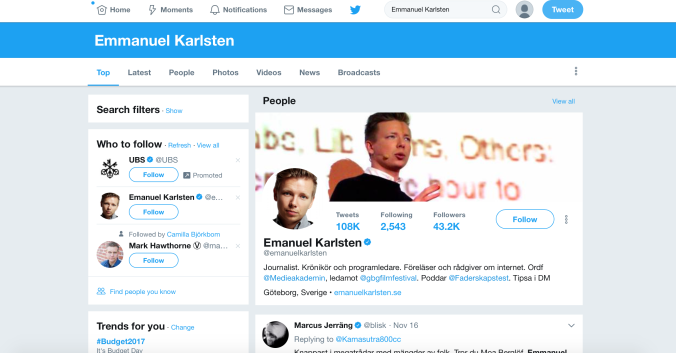
The most basic way of finding people to follow on Twitter, is simply by searching for them by name.
Next, I used a third party tool to find further potential people to follow. I did this by using Tweepi. Tweepi has a lot of different features, some of which you need to pay for. However, I chose to use its free services which allows you to find and follow other people’s followers.
I could see why this could be an effective way of finding people that might be of interest, either for you personally, or as potential followers in the future. However, I think you should be very careful to carelessly start following random people, as it might have the opposite effect of what you want. That is why I did not chose to follow all the 5000 of the Swedish communicator Fredrik Wass’s followers that was recommended to me by Tweepi. However, there might be someone that captures your interest, and that you might not have found otherwise that you can follow.
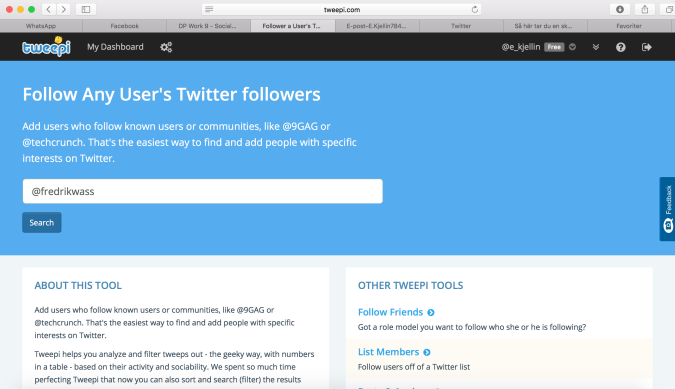
On Tweepi you can name the person whose followers you might find interesting. This is a good way of finding an audience who might be interested in what you are writing about.
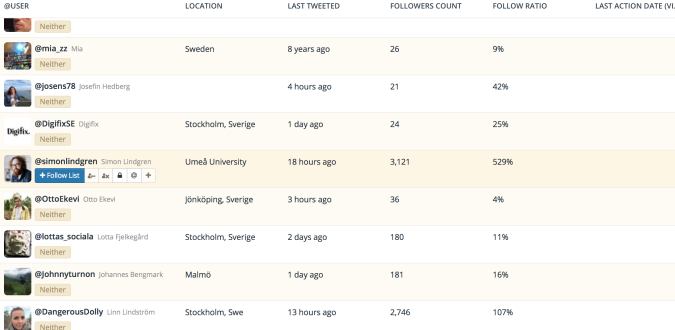
Even if you might not follow every one on this list, there might be someone that captures your interest and that you might not have found otherwise.
Next, I wanted to find lists on Twitter to subscribe to. Lists are curated groups of Twitter accounts. I followed my tutor’s advice to visit Nina Diamond’s profile, a journalist who has created several lists. I also visited Sweden’s previous minister of foreign affairs to see what kinds of lists he had subscribed to. I eventually found a few that interested me.
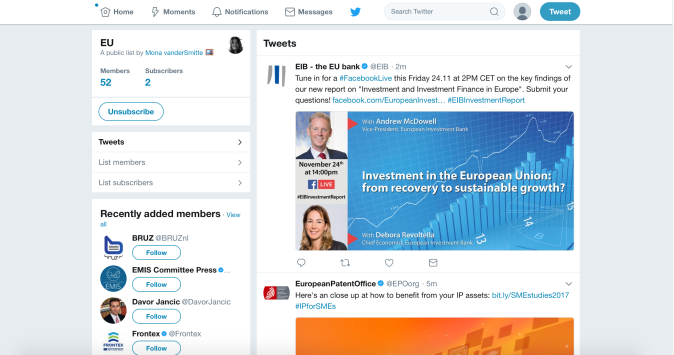
Finding lists that cover a specific subject or area is a great way of getting a variation of different perspectives.
At this time my timeline needed to get organized and I researched two Twitter tools to help me with this: TweetDeck and Crowdfire.
TweetDeck allowed me to organize the content of my timeline in to different columns. For instance; I wanted to start a column that gathered tweets about my employer back home. I also wanted to see what people were writing, about an initiative for increasing democratic engagement for younger kids in my hometown in Sweden.
Theres is no question TweetDeck will make you even more up to date, as it will organize your timeline more effectively. Instead of missing out on tweets about politics, that are mixed with tweets about the best Christmas hot chocolate recipe, you can now gather it in category-specific columns of your own choice. It is also possible to tweet directly from the page, in real time or scheduled, which I also tried out.
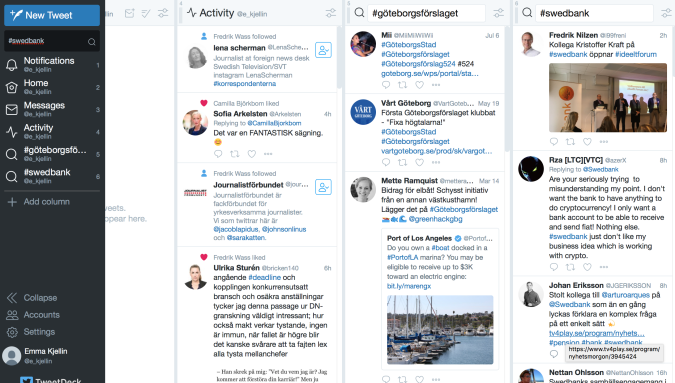
TweetDeck helps you to organize your timeline. You can create your own columns that collects tweets with a specific topic or hashtag.
Crowdfire would be a great tool to use if I was more active on social media and wanted to post things more effectively and timely on several different platforms. I can’t help of feeling a bit sad however, to realize that Crowdfire also actively suggest articles for you to share. This leaves very little for the user to research her- or himself. I wonder, where does the authenticity go, if nothing that you post comes from your own initiative, but rather from a robot?
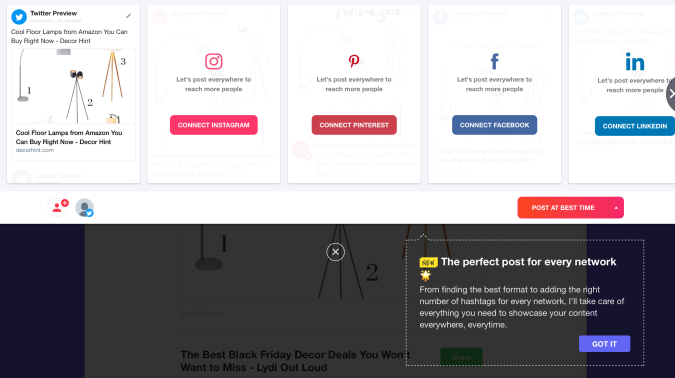
Crowfire helps you to distribute your material on to several different platforms.
After this, it was time to post my very first tweets. Having an organized timeline on Twitter and following several people that might be potential followers to you, is not enough. Of course you also need to post your own qualitative content that will engage your audience.
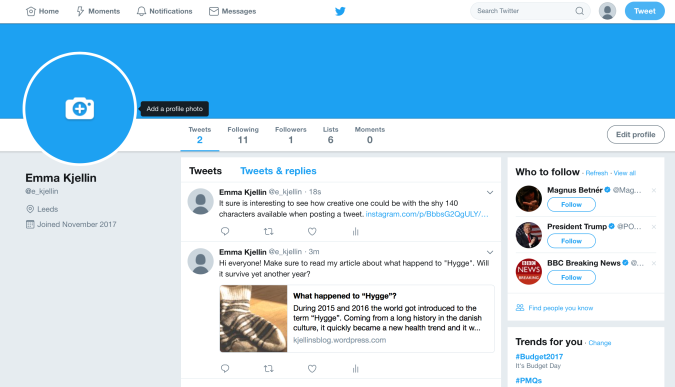
Having an organized timeline on Twitter and following several people that might be potential followers to you, is not enough. Of course you also need to post your own qualitative content that will engage your audience. Here is my very first posts and there is more to come.
I think this was a very informative and effective workshop. I am amazed of how many tools there are out there that will help you do the “dirty work” when managing your social media platforms. Crowdfire for instance, that gives you suggestions of other posts and articles to share on your account. TweetDeck, that organize your timeline on Twitter, which will save you a great deal of time. I can definitely see myself using these tools in the future.
Trump’s recent tweets
Read my Instagram post about Trump’s resent tweets here.
Planet Blue 2 comes with an important message
Read my article on the premier of Blue Planet 2 here.
Blogger claims there’s no future for the health trend “hygge”

Will Hygge be more than a marketing device in the UK?
(Updated article, workshop #5)
By Emma Kjellin
Kayleigh Tanner, author of Hello Hygge blog, claims in an interview that she can’t imagine the health trend hygge to survive in the UK the years to come. Rather than being a health trend, it has become more of a marketing device.
During 2015 and 2016 the world got introduced to the term “hygge” which is described as “A quality of cosiness and comfortable conviviality that engenders a feeling of contentment or well-being”. It originates from the 19th century from a Norwegian word that means “hug”. Coming from a long history in the Danish culture, it quickly became a new health trend, not only in the UK but all around the world.
Marketing device
However, Tanner says that the trend has become somewhat of a marketing device and that we seem to have lost the core meaning of its definition.
“I think most people in the UK kind of discarded hygge as just another trend” says Tanner.

What was first a trend encouraging an atmosphere of contentment and wellbeing has now become a marketing trick.
Negative spin
Meik Wiking, author of The little book of Hygge, one of the many books created during this time, describes that hygge is mainly about creating an atmosphere and an experience, rather than things.
However, just like Tanner describes, the term has appeared more frequently in sales ads for candles, blankets and other things that are associated with hygge. Eventually the tone changed when the word appeared in articles.
“Far from being a radical new concept and sexy lifestyle trend, hygge is festive twee, repurposed for an Ikea-addled generation”, The Telegraph wrote in the end of 2016
The trend has come to an end
Even though Tanner claims that she will continue to spread the word of hygge through her blog, she can’t imagine Hygge to carry on the years to come.
What happened to “Hygge”?
During 2015 and 2016 the world got introduced to the term “Hygge”. Coming from a long history in the danish culture, it fastly became the new health trend and it was chosen as word of the year in 2016 by Oxford Dictionaries. Question is, has the trend managed to survive?
From culture to marketing
Hygge is described as “A quality of cosiness and comfortable conviviality that engenders a feeling of contentment or well-being”. Meik Wiking, author of The little book of Hygge describes that it is about creating an atmosphere and an experience, rather than about things.
However, the term has appeared more frequently in sales ads for candles, blankets and other things that are associated with hygge. “Far from being a radical new concept and sexy lifestyle trend, hygge is festive twee, repurposed for an Ikea-addled generation”, The Telegraph wrote in the end of 2016.
Marketing device
Kayleigh Tanner, author of Hello Hygge blog agrees that the trend has become somewhat of a marketing device and that we seem to have lost the core meaning of its definition. “I think most people in the UK kind of discarded hygge as just another trend” says Kayleigh.
The question is, does hygge has the potential to get rid of the commercialism stamp, or will it fade away? Even though Kayleigh Tanner will continue to spread the word of hygge through her blog, she can’t imagine Hygge to carry on the years to come.
Surfing her way around the world
At first, you might find it strange to find a person, living hundreds of miles away from the sea, to have an interest for surfing. Lara Peterke, a 22 year old student from Germany would at first not appear to be a surfer girl. She lives in a small town in the absolute center of Europe, miles from the ocean. At one point during our conversation however, she lifts up her sweater and exposes her ribcage. As I leaned forward I saw a figure, a tattoo, with the shape of a wave. And here’s where the story begins.
Surfing is a family legacy
Lara Peterke comes from a town called Heidenheim an der Brenz in Germany. With a distance of six hours to nearest ocean, surfing would appear as an almost impossible hobby.
It turns out, however, that Lara’s father is a former windsurfer and her older sister is quite the expert in kitesurfing. One might say it runs in the family, and she’s always been drawn to the sea. “I love the ocean, and it’s such a sorrow for me not to be able to surf every day” she says longingly.
It was only a matter of time until Lara would also stand on top of a surfing board.
Traveling the world
Thanks to an interest for traveling, it was finally during a holiday, when Lara was only 10 years old that she tried windsurfing for the very first time. In her teenage years she later on started regular surfing. “I thought it was so cool to be able catch a wave!” she says as her face lights up in a big smile. Ever since then, Lara has surfed in countries such as France, Italy Spain and Portugal. It has always been necessary to go abroad to catch the good waves.
Student life didn’t suit the surfer lifestyle
As she became a student and moved to Stuttgart, there didn’t seem to be enough time or finances to spontaneously go abroad to surf. And that’s where the tattoo comes in. “ If I wasn’t going to be able to surf, at least I wanted something to feel close to the ocean. Now i will always be able to bring the ocean with me”.
Even though it’s been two years since last time Lara surfed, the interest has not cooled down. For next year, she’s made a promise to herself; “ I am going to Bali”.